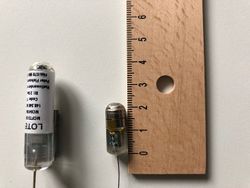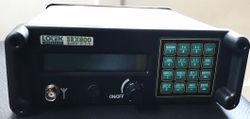Radio frequency identification with passive integrated transponder (PIT tagging)
Quick summary
Date:
Type: Tool
Suitable for the following [[::Category:Measures|measures]]:
Introduction
RFID (Radio Frequency Identification) system uses PIT (Passive Integrated Transponder) tags to detect and follow individuals. The PIT tags (Figure 7), each with a unique alphanumeric code, are of small size and benefit of indefinite operational life (no battery is required). When entering in the detection area of a RFID antenna (Figure 8), the reader is responsible of powering and communicating with the tag. The tag antenna captures energy from a tag and transfers the tag’s ID.
Low Frequency RFID uses magnetic fields that can go through water in contrast to high frequency RFID. Owing to the shorter detection range (less than 2 m perpendicular to the antenna plane) RFID technology is mainly suitable for smaller systems. Two different technologies can be used (source: https://www.oregonrfid.com/resources/hdx-fdx/):
- Half duplex RFID (HDX): A half duplex RFID reader generates short magnetic pulses that wirelessly charge a capacitor (Figure 9) inside an HDX tag. When the charge field turns off, the tag uses the stored power to send the tag number back to the reader (Figure 10) without interference from the reader.
- Full duplex RFID (FDX): Full duplex RFID generates a continuous magnetic field which powers the tag to respond immediately. Tags repeat their message, while powered by the field, up to 30 times per second.
The whole system has to be supplied by DC power, powered by different ways:
- Battery
- Solar
- Thermoelectric generator
- Micro hydro (to charge the batteries)
- A power supply can transform the AC power to DC power
Application
Radio telemetry is a standard tool for the study of spatial ecology and migration of fishes. It can be applied for a variety of fish migration studies. The passage corridor at a hydropower plant can be evaluated and information is gathered how the fish is approaching the site. The searching phase in front of a hydropower plant can be documented for downstream and upstream migrations.
Stationary and mobile tracking are often used. Stationary tracking continuously tracks a signal, but its application is limited to specific sites. Fish presence or absence at a site, and passage and movement rates between sites can be detected (Eiler, 2012). Mobile tracking allows the survey of an extended area.
The application for radio telemetry at hydropower plants is mainly detecting passage routes and linear migrations in a river system. However, acoustic telemetry (section 1.2) became very popular and is more suitable for studies with the goal of documenting the detailed behaviour patterns of fishes in front of a hydropower plant (forebay). There are certain advantages and disadvantages for acoustic and radio telemetry. Both methods are adequate depending on the study objectives.
Radio telemetry is applied worldwide. Beeman et al (2012) published a comprehensive study on the effects of hydroelectric dams on fish populations on the Columbia River and on the Snake River. The downstream migration of Chinook salmon and anadromous rainbow trout at different sites were extensively documented.
Radio telemetry studies will be applied within the FIThydro project in the Aare River (HP Bannwil) to study the migration corridor and the timing of the migration. Mainly cyprinid fish species will be tracked. The main question is if fish are using the spillway corridor or if they migrate with the main flow through the turbine intakes. On the whole, the downstream migration of cyprinid fish species at hydropower plants has been incompletely studied so far and the Bannwil Test Case should contribute to a better understanding of cyprinid fish migration.
Other information
Radio telemetry is gear-intensive with high initial costs for the equipment, but also for transmitters, the preparation and station installation. Radio telemetry experiments have to be considered as animal experiments and special permissions from the local authorities are needed.
Relevant literature
- Beeman, J. W., E. E. Hockersmith & J. R. Stevenson. 2012. Design and performance of radio telemetry systems for assessing juvenile fish passage at three hydroelectric dams. Pages 281-302 in N. S. Adams, J. W. Beeman & J. H. Eiler. Editors. Telemetry techniques: a user guide for fisheries research. American Fisheries Society, Bethesda, Maryland.
- Eiler, J. H. 2012. Tracking aquatic animals with radio telemetry. Pages 163-204 in N. S. Adams, J. W. Beeman & J. H. Eiler. Editors. Telemetry techniques: a user guide for fisheries research. American Fisheries Society, Bethesda, Maryland.


